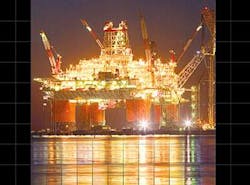Thunder Horse development includes world’s largest PDQ semi
April 2005 saw the loadout of the production-drilling-quarters (PDQ) semisubmersible platform for the BP PLC operated Thunder Horse field in the Gulf of Mexico. BP says the PDQ is the largest in the world, weighing more than 50,000 tons.
The PDQ is moored in 6,050 ft of water of Mississippi Canyon Block 778, about 150 miles southeast of New Orleans.
BP with a 75% working interest operates the development. Its partner ExxonMobil Corp. holds the remaining interest.
BP expects first oil in the second half of 2005.
Facility design
The PDQ is designed to process 250,000 bo/d, 200 MMcfd of gas, and 140,000 b/d of produced water. The platform also is equipped for the injection of 200,000-300,000 bw/d into the reservoir.
The main deck dimensions are 367 by 446 ft.
The topsides has three production-utilities modules with a maximum 21,000-ton lift weight. The platform can generate 90 Mw of power from its main generations. Its derrick has a 2-million-lb rating and provides auxiliary hoisting capability.
The hull has a dry transport weight of 59,500 tonnes and a displacement of 129,000 tonnes.
The PDQ has a 98-ft normal draft. Sixteen 53⁄4-in. wire ropes and chains connected to suction piles hold the PDQ on location.
The quarters on the platform can house up to 229 persons.
The PDQ hull was built in Okpo, Korea, while the construction of the topsides modules took place in Morgan City, La.
Thunder Horse field
The Thunder Horse project will develop two adjacent fields: north and south.
Four blocks, Mississippi Canyon, Blocks 777, 778, 821, and 822, hold the first discovery known as Thunder Horse South. The initial Thunder Horse discovery well, Mississippi Canyon, Block 778, Well No. 1, was temporarily abandoned on June 29, 1999. This well is in about 6,000 ft of water.
The remaining four blocks in the unit, Mississippi Canyon, Blocks 775, 776, 819, and 820, hold the second discovery, Thunder Horse North. Its discovery well, Mississippi Canyon, Block 776, Well No 1, was temporarily abandoned on November 22, 2000. This well is in about 5,400 ft of water.
The fields are the largest oil and gas accumulations found to date in the deep water of the Gulf of Mexico. BP expects to recover more than 1 billion boe during the life of the project.
The producing reservoirs are Upper Miocene turbidite sandstones at depths up to 27,000 ft.
The development plans include a network of 25 wet-tree subsea wells and subsea manifolds to produce the high 17,400-psi pressure and high 275° F. temperature reservoirs.
A predrilling program started in early 2004.
BP expects some wells to produce at rates up to 50,000 bo/d.
The development plans include exporting the oil and gas to existing shelf and onshore interconnections via the Mardi Gras Transportation System. ✦

